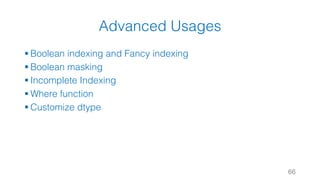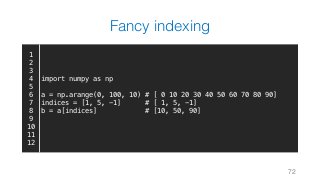Scientific Computing with Python - NumPy | WeiYuan
- 1. Scientific Computing with Python - NumPy 2017/08/03 (Thus.) WeiYuan
- 2. site: v123582.github.io line: weiwei63 § 全端⼯程師 + 資料科學家 略懂⼀點網站前後端開發技術,學過資料探勘與機器 學習的⽪⽑。平時熱愛參與技術社群聚會及貢獻開源 程式的樂趣。
- 3. Outline § About NumPy § Ndarray § Create a new Array § Property of Array § Operation of Array § Matrix § Advanced Usages 3
- 4. Outline § About NumPy § Ndarray § Create a new Array § Property of Array § Operation of Array § Matrix § Advanced Usages 4
- 5. the Ecosystem of Python 5Reference: https://www.edureka.co/blog/why-you-should-choose-python-for-big-data
- 7. About NumPy § NumPy is the fundamental package for scientific computing with Python. It contains among other things: • a powerful N-dimensional array object • sophisticated (broadcasting) functions • tools for integrating C/C++ and Fortran code • useful linear algebra, Fourier transform, and random number capabilities • be used as an efficient multi-dimensional container of generic data. 7
- 8. About NumPy § NumPy is the fundamental package for scientific computing with Python. It contains among other things: • a powerful N-dimensional array object • sophisticated (broadcasting) functions • tools for integrating C/C++ and Fortran code • useful linear algebra, Fourier transform, and random number capabilities • be used as an efficient multi-dimensional container of generic data. 8
- 9. Try it! § #練習:Import the numpy package under the name np 9
- 10. Try it! § #練習:Print the numpy version and the configuration 10
- 11. Outline § About NumPy § Ndarray § Create a new Array § Property of Array § Operation of Array § Matrix § Advanced Usages 11
- 12. Ndarray § shape § ndim § dtype § size § itemsize § data 12 1 2 3 4 5 6 7 8 9 10 11 12 from numpy import * a = array([[ 0, 1, 2, 3, 4], [ 5, 6, 7, 8, 9], [10, 11, 12, 13, 14] ])
- 13. Ndarray § shape § ndim § dtype § size § itemsize § data 13 1 2 3 4 5 6 7 8 9 10 11 12 from numpy import * a = array([[ 0, 1, 2, 3, 4], [ 5, 6, 7, 8, 9], [10, 11, 12, 13, 14] ]) a.shape # (3, 5) a.ndim # 2 a.dtype.name # 'int32’ a.size # 15 a.itemsize # 4 type(a) # numpy.ndarray
- 14. Outline § About NumPy § Ndarray § Create a new Array § Property of Array § Operation of Array § Matrix § Advanced Usages 14
- 15. Create a new Ndarray § One Dimension Array (1dnarray) § Multiple Dimension Array (ndarray) § Zeros, Ones, Empty § arange and linspace § random array § array from list/tuple 15
- 16. Create a new Ndarray § One Dimension Array (1dnarray) 16 1 2 3 4 5 6 7 8 9 import numpy as np arr1 = np.array([0, 1, 2, 3, 4]) # array([0 1 2 3 4]) type(arr1) # <type 'numpy.ndarray'> arr1.dtype # dtype('int64') array( )
- 17. Create a new Ndarray § One Dimension Array (1dnarray) 17 1 2 3 4 5 6 7 8 9 import numpy as np arr1 = np.array([0, 1, 2, 3, 4]) # array([0 1 2 3 4]) type(arr1) # <type 'numpy.ndarray'> arr1.dtype # dtype('int64') arr2 = np.array([1.2, 2.4, 3.6]) # array([1.2, 2.4, 3.6]) type(arr2) # <type 'numpy.ndarray'> arr2.dtype # dtype('float64') array( )
- 18. Create a new Ndarray § Question:How to assign data type for an array ? 18
- 19. Create a new Ndarray § Multiple Dimension Array (ndarray) 19 1 2 3 4 5 6 7 8 9 import numpy as np a = np.array([[1, 2, 3], [4, 5, 6]]) # array([[1, 2, 3], # [4, 5, 6]]) array( )
- 20. Create a new Ndarray § Question:How to change shape from 1-d array ? 20
- 21. Create a new Ndarray § Zeros, Ones, Empty 21 1 2 3 4 5 6 7 8 9 import numpy as np zeros = np.zeros(5) # array([ 0., 0., 0., 0., 0.]) zeros( )
- 22. Create a new Ndarray § Zeros, Ones, Empty 22 1 2 3 4 5 6 7 8 9 import numpy as np zeros = np.ones(5) # array([ 1., 1., 1., 1., 1.]) ones( )
- 23. Create a new Ndarray § Zeros, Ones, Empty 23 1 2 3 4 5 6 7 8 9 import numpy as np zeros = np.empty(5) # array([ 0., 0., 0., 0., 0.]) empty( )
- 24. Create a new Ndarray § arange and linspace 24 1 2 3 4 5 6 7 8 9 import numpy as np arange = np.arange(5) # array([0 1 2 3 4]) arange( )
- 25. Create a new Ndarray § arange and linspace 25 1 2 3 4 5 6 7 8 9 import numpy as np linspace = np.linspace(0, 4, 5) # array([ 0., 1., 2., 3., 4.]) linspace( )
- 26. Create a new Ndarray § random array 26 1 2 3 4 5 6 7 8 9 import numpy as np linspace = np.random.randint(0, 2, size=4) # array([ 0, 1, 1, 1]) random.randint( )
- 27. Try it! § #練習:Create a 3x3x3 array with random values 27
- 28. Try it! § #練習:Find indices of non-zero elements 28
- 29. Create a new Ndarray § array from list/tuple 29 1 2 3 4 5 6 7 8 9 import numpy as np x = [1,2,3] a = np.asarray(x) x = (1,2,3) a = np.asarray(x) asarray( )
- 30. Try it! § #練習:Create a null vector of size 10 30
- 31. Try it! § #練習:Create a vector with values ranging from 10 to 49 31
- 32. Try it! § #練習:Create a 3x3 identity matrix 32
- 33. Outline § About NumPy § Ndarray § Create a new Array § Property of Array § Operation of Array § Matrix § Advanced Usages 33
- 34. Property of Ndarray § shape § ndim § dtype § size § itemsize § data 34 1 2 3 4 5 6 7 8 9 10 11 12 import numpy as np a = np.array( [[11, 12, 13, 14, 15], [16, 17, 18, 19, 20], [21, 22, 23, 24, 25], [26, 27, 28 ,29, 30], [31, 32, 33, 34, 35] ])
- 35. Property of Ndarray § shape § ndim § dtype § size § itemsize § data 35 1 2 3 4 5 6 7 8 9 10 11 12 print(type(a)) print(a.shape) print(a.ndim) print(a.dtype) print(a.size) print(a.itemsize) print(a.nbytes)
- 36. Try it! § #練習:How to find the memory size of any array 36
- 37. data type 37 § Question:How to assign data type for an array ? 1. Set dtype with create the array 2. Change dtype function
- 38. 1. Set dtype with create the array 38 1 2 3 4 5 6 7 8 9 x = numpy.array([1,2.6,3], dtype = numpy.int64) print(x) # print(x.dtype) # x = numpy.array([1,2,3], dtype = numpy.float64) print(x) # print(x.dtype) # array( )
- 39. 2. Change dtype function 39 1 2 3 4 5 6 7 8 9 x = numpy.array([1,2.6,3], dtype = numpy.float64) y = x.astype(numpy.int32) print(y) # [1 2 3] print(y.dtype) z = y.astype(numpy.float64) print(z) # [ 1. 2. 3.] print(z.dtype) astype( )
- 40. 40
- 41. data shape 41 § Question:How to change shape from 1-d array ? 1. Set multiple array with create the array 2. Assign new shape to shape property 3. Change shape function
- 42. 1. Set multiple array with create the array 42 1 2 3 4 5 6 7 8 9 import numpy as np a = np.array([[1,2,3],[4,5,6]]) a.shape # (2, 3) array( )
- 43. 2. Assign new shape to shape property 43 1 2 3 4 5 6 7 8 9 a = np.array([[1,2,3],[4,5,6]]) a.shape = (3,2) a # [[1, 2], [3, 4], [5, 6]] array( )
- 44. 3. Change shape function 44 1 2 3 4 5 6 7 8 9 a = np.array([[1,2,3],[4,5,6]]) b = a.reshape(3,2) b # [[1, 2], [3, 4], [5, 6]] reshape( )
- 45. 3. Change shape function 45 1 2 3 4 5 6 7 8 9 a = np.array([[1,2,3],[4,5,6]]) b = a.reshape(3,2) b # [[1, 2], [3, 4], [5, 6]] a.resize(3,2) a # [[1, 2], [3, 4], [5, 6]] resize( )
- 46. Try it! § #練習:Create a 3x3 matrix with values ranging from 0 to 8 46
- 47. index and slicing § index § slicing 47 1 2 3 4 array[0] # 0 array[1] # 1 array[-1] # 4 1 2 3 4 5 array[1:3] # [1, 2] array[:4] # [0, 1, 3] array[3:] # [3, 4] array[1:4:2] # [1, 3] array[::-1] # [4, 3, 2, 1, 0] ([0, 1, 2, 3, 4])
- 48. index and slicing § index § slicing 48 1 2 3 4 array[1] # [0, 1] array[1][0] # 0 array[1][1] # 1 array[2][0] # 2 1 2 3 4 5 array[0:2] # [[0, 1], [2, 3]] array[:2] # [[0, 1], [2, 3]] array[2:] # [[4, 5]] ( [0, 1, 0, 1, 0], [2, 3, 2, 3, 2], [4, 5, 4, 5, 4] )
- 49. index and slicing § slicing 49 1 2 3 4 array[0, 1:4] # [1, 0, 1] array[[0, 0, 0], [1, 2, 3]] array[1:3, 0] # [1, 3, 5] array[[1, 2], [0, 0, 0]] ( [0, 1, 0, 1, 0], [2, 3, 2, 3, 2], [4, 5, 4, 5, 4] )
- 50. Try it! § #練習:Create a null vector of size 10 but the fifth value which is 1 50
- 51. Try it! § #練習:Reverse a vector (first element becomes last) 51
- 52. Try it! § #練習:Create a 2d array with 1 on the border and 0 inside 52
- 53. Try it! § #練習:Create a 8x8 matrix and fill it with a checkerboard pattern 53
- 54. Try it! § #練習: 54 1 2 3 4 5 6 7 8 9 import numpy as np a = np.array([[1,2,3],[3,4,5],[4,5,6]]) # 第二列元素 # 第二行元素 # 除了第二列的元素
- 56. Outline § About NumPy § Ndarray § Create a new Array § Property of Array § Operation of Array § Matrix § Advanced Usages 56
- 59. ufunc 59
- 60. staticstic 60
- 61. Outline § About NumPy § Ndarray § Create a new Array § Property of Array § Operation of Array § Matrix § Advanced Usages 61
- 62. 2d-array 62
- 63. Matrix 63
- 65. Outline § About NumPy § Ndarray § Create a new Array § Property of Array § Operation of Array § Matrix § Advanced Usages 65
- 66. Advanced Usages § Boolean indexing and Fancy indexing § Boolean masking § Incomplete Indexing § Where function § Customize dtype 66
- 67. Thanks for listening. 2017/08/03 (Thus.) Scientific Computing with Python – NumPy Wei-Yuan Chang [email protected] v123582.github.io



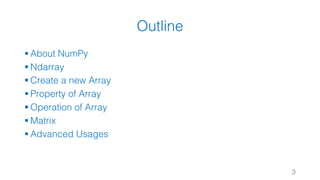








![Ndarray
§ shape
§ ndim
§ dtype
§ size
§ itemsize
§ data
12
1
2
3
4
5
6
7
8
9
10
11
12
from numpy import *
a = array([[ 0, 1, 2, 3, 4],
[ 5, 6, 7, 8, 9],
[10, 11, 12, 13, 14]
])](https://image.slidesharecdn.com/pythonnumpy-170801154257/85/Scientific-Computing-with-Python-NumPy-WeiYuan-12-320.jpg)
![Ndarray
§ shape
§ ndim
§ dtype
§ size
§ itemsize
§ data
13
1
2
3
4
5
6
7
8
9
10
11
12
from numpy import *
a = array([[ 0, 1, 2, 3, 4],
[ 5, 6, 7, 8, 9],
[10, 11, 12, 13, 14]
])
a.shape # (3, 5)
a.ndim # 2
a.dtype.name # 'int32’
a.size # 15
a.itemsize # 4
type(a) # numpy.ndarray](https://image.slidesharecdn.com/pythonnumpy-170801154257/85/Scientific-Computing-with-Python-NumPy-WeiYuan-13-320.jpg)
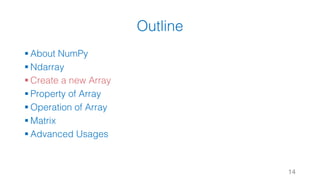

![Create a new Ndarray
§ One Dimension Array (1dnarray)
16
1
2
3
4
5
6
7
8
9
import numpy as np
arr1 = np.array([0, 1, 2, 3, 4]) # array([0 1 2 3 4])
type(arr1) # <type 'numpy.ndarray'>
arr1.dtype # dtype('int64')
array( )](https://image.slidesharecdn.com/pythonnumpy-170801154257/85/Scientific-Computing-with-Python-NumPy-WeiYuan-16-320.jpg)
![Create a new Ndarray
§ One Dimension Array (1dnarray)
17
1
2
3
4
5
6
7
8
9
import numpy as np
arr1 = np.array([0, 1, 2, 3, 4]) # array([0 1 2 3 4])
type(arr1) # <type 'numpy.ndarray'>
arr1.dtype # dtype('int64')
arr2 = np.array([1.2, 2.4, 3.6]) # array([1.2, 2.4, 3.6])
type(arr2) # <type 'numpy.ndarray'>
arr2.dtype # dtype('float64')
array( )](https://image.slidesharecdn.com/pythonnumpy-170801154257/85/Scientific-Computing-with-Python-NumPy-WeiYuan-17-320.jpg)

![Create a new Ndarray
§ Multiple Dimension Array (ndarray)
19
1
2
3
4
5
6
7
8
9
import numpy as np
a = np.array([[1, 2, 3], [4, 5, 6]])
# array([[1, 2, 3],
# [4, 5, 6]])
array( )](https://image.slidesharecdn.com/pythonnumpy-170801154257/85/Scientific-Computing-with-Python-NumPy-WeiYuan-19-320.jpg)

![Create a new Ndarray
§ Zeros, Ones, Empty
21
1
2
3
4
5
6
7
8
9
import numpy as np
zeros = np.zeros(5)
# array([ 0., 0., 0., 0., 0.])
zeros( )](https://image.slidesharecdn.com/pythonnumpy-170801154257/85/Scientific-Computing-with-Python-NumPy-WeiYuan-21-320.jpg)
![Create a new Ndarray
§ Zeros, Ones, Empty
22
1
2
3
4
5
6
7
8
9
import numpy as np
zeros = np.ones(5)
# array([ 1., 1., 1., 1., 1.])
ones( )](https://image.slidesharecdn.com/pythonnumpy-170801154257/85/Scientific-Computing-with-Python-NumPy-WeiYuan-22-320.jpg)
![Create a new Ndarray
§ Zeros, Ones, Empty
23
1
2
3
4
5
6
7
8
9
import numpy as np
zeros = np.empty(5)
# array([ 0., 0., 0., 0., 0.])
empty( )](https://image.slidesharecdn.com/pythonnumpy-170801154257/85/Scientific-Computing-with-Python-NumPy-WeiYuan-23-320.jpg)
![Create a new Ndarray
§ arange and linspace
24
1
2
3
4
5
6
7
8
9
import numpy as np
arange = np.arange(5)
# array([0 1 2 3 4])
arange( )](https://image.slidesharecdn.com/pythonnumpy-170801154257/85/Scientific-Computing-with-Python-NumPy-WeiYuan-24-320.jpg)
![Create a new Ndarray
§ arange and linspace
25
1
2
3
4
5
6
7
8
9
import numpy as np
linspace = np.linspace(0, 4, 5)
# array([ 0., 1., 2., 3., 4.])
linspace( )](https://image.slidesharecdn.com/pythonnumpy-170801154257/85/Scientific-Computing-with-Python-NumPy-WeiYuan-25-320.jpg)
![Create a new Ndarray
§ random array
26
1
2
3
4
5
6
7
8
9
import numpy as np
linspace = np.random.randint(0, 2, size=4)
# array([ 0, 1, 1, 1])
random.randint( )](https://image.slidesharecdn.com/pythonnumpy-170801154257/85/Scientific-Computing-with-Python-NumPy-WeiYuan-26-320.jpg)


![Create a new Ndarray
§ array from list/tuple
29
1
2
3
4
5
6
7
8
9
import numpy as np
x = [1,2,3]
a = np.asarray(x)
x = (1,2,3)
a = np.asarray(x)
asarray( )](https://image.slidesharecdn.com/pythonnumpy-170801154257/85/Scientific-Computing-with-Python-NumPy-WeiYuan-29-320.jpg)




![Property of Ndarray
§ shape
§ ndim
§ dtype
§ size
§ itemsize
§ data
34
1
2
3
4
5
6
7
8
9
10
11
12
import numpy as np
a = np.array(
[[11, 12, 13, 14, 15],
[16, 17, 18, 19, 20],
[21, 22, 23, 24, 25],
[26, 27, 28 ,29, 30],
[31, 32, 33, 34, 35]
])](https://image.slidesharecdn.com/pythonnumpy-170801154257/85/Scientific-Computing-with-Python-NumPy-WeiYuan-34-320.jpg)
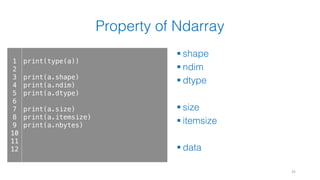


![1. Set dtype with create the array
38
1
2
3
4
5
6
7
8
9
x = numpy.array([1,2.6,3], dtype = numpy.int64)
print(x) #
print(x.dtype) #
x = numpy.array([1,2,3], dtype = numpy.float64)
print(x) #
print(x.dtype) #
array( )](https://image.slidesharecdn.com/pythonnumpy-170801154257/85/Scientific-Computing-with-Python-NumPy-WeiYuan-38-320.jpg)
![2. Change dtype function
39
1
2
3
4
5
6
7
8
9
x = numpy.array([1,2.6,3], dtype = numpy.float64)
y = x.astype(numpy.int32)
print(y) # [1 2 3]
print(y.dtype)
z = y.astype(numpy.float64)
print(z) # [ 1. 2. 3.]
print(z.dtype)
astype( )](https://image.slidesharecdn.com/pythonnumpy-170801154257/85/Scientific-Computing-with-Python-NumPy-WeiYuan-39-320.jpg)


![1. Set multiple array with create the array
42
1
2
3
4
5
6
7
8
9
import numpy as np
a = np.array([[1,2,3],[4,5,6]])
a.shape # (2, 3)
array( )](https://image.slidesharecdn.com/pythonnumpy-170801154257/85/Scientific-Computing-with-Python-NumPy-WeiYuan-42-320.jpg)
![2. Assign new shape to shape property
43
1
2
3
4
5
6
7
8
9
a = np.array([[1,2,3],[4,5,6]])
a.shape = (3,2)
a # [[1, 2], [3, 4], [5, 6]]
array( )](https://image.slidesharecdn.com/pythonnumpy-170801154257/85/Scientific-Computing-with-Python-NumPy-WeiYuan-43-320.jpg)
![3. Change shape function
44
1
2
3
4
5
6
7
8
9
a = np.array([[1,2,3],[4,5,6]])
b = a.reshape(3,2)
b # [[1, 2], [3, 4], [5, 6]]
reshape( )](https://image.slidesharecdn.com/pythonnumpy-170801154257/85/Scientific-Computing-with-Python-NumPy-WeiYuan-44-320.jpg)
![3. Change shape function
45
1
2
3
4
5
6
7
8
9
a = np.array([[1,2,3],[4,5,6]])
b = a.reshape(3,2)
b # [[1, 2], [3, 4], [5, 6]]
a.resize(3,2)
a # [[1, 2], [3, 4], [5, 6]]
resize( )](https://image.slidesharecdn.com/pythonnumpy-170801154257/85/Scientific-Computing-with-Python-NumPy-WeiYuan-45-320.jpg)

![index and slicing
§ index
§ slicing
47
1
2
3
4
array[0] # 0
array[1] # 1
array[-1] # 4
1
2
3
4
5
array[1:3] # [1, 2]
array[:4] # [0, 1, 3]
array[3:] # [3, 4]
array[1:4:2] # [1, 3]
array[::-1] # [4, 3, 2, 1, 0]
([0, 1, 2, 3, 4])](https://image.slidesharecdn.com/pythonnumpy-170801154257/85/Scientific-Computing-with-Python-NumPy-WeiYuan-47-320.jpg)
![index and slicing
§ index
§ slicing
48
1
2
3
4
array[1] # [0, 1]
array[1][0] # 0
array[1][1] # 1
array[2][0] # 2
1
2
3
4
5
array[0:2] # [[0, 1], [2, 3]]
array[:2] # [[0, 1], [2, 3]]
array[2:] # [[4, 5]]
( [0, 1, 0, 1, 0],
[2, 3, 2, 3, 2],
[4, 5, 4, 5, 4] )](https://image.slidesharecdn.com/pythonnumpy-170801154257/85/Scientific-Computing-with-Python-NumPy-WeiYuan-48-320.jpg)
![index and slicing
§ slicing
49
1
2
3
4
array[0, 1:4] # [1, 0, 1]
array[[0, 0, 0], [1, 2, 3]]
array[1:3, 0] # [1, 3, 5]
array[[1, 2], [0, 0, 0]]
( [0, 1, 0, 1, 0],
[2, 3, 2, 3, 2],
[4, 5, 4, 5, 4] )](https://image.slidesharecdn.com/pythonnumpy-170801154257/85/Scientific-Computing-with-Python-NumPy-WeiYuan-49-320.jpg)




![Try it!
§ #練習:
54
1
2
3
4
5
6
7
8
9
import numpy as np
a = np.array([[1,2,3],[3,4,5],[4,5,6]])
# 第二列元素
# 第二行元素
# 除了第二列的元素](https://image.slidesharecdn.com/pythonnumpy-170801154257/85/Scientific-Computing-with-Python-NumPy-WeiYuan-54-320.jpg)
![Try it!
§ #練習:
55
1
2
3
4
array[::2,::2]
array[:, 1]](https://image.slidesharecdn.com/pythonnumpy-170801154257/85/Scientific-Computing-with-Python-NumPy-WeiYuan-55-320.jpg)










